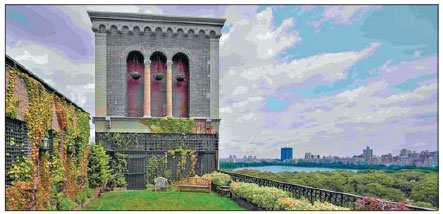Top News
Visiting New York’s exclusive rooftop gardens
Updated: 2011-04-24 08:06
By Nick Zieminski (China Daily)
|
A residential terrace on the 76th floor of Manhattan's Time Warner Center, in what could be New York's highest garden. |
|
A 700-square-foot (65 square meters) lawn is seen in Central Park West. Central Park itself can be seen just beyond the barrier. |
Eagle-eyed Manhattan pedestrians may spy them high above the street: lush, tree-lined gardens, whose defiant greenery interrupts an urban panorama of concrete and glass.
Tourists will never see them up close. Few New Yorkers will. Those who notice these airy playgrounds, some just a few floors above the sidewalk, may wonder how it would feel to step out of one's living room into a private green space without giving up the perks of urban living.
A new book, Rooftop Gardens: The Terraces, Conservatories and Balconies of New York satisfies that curiosity with a photographic tour of 28 such exclusive oases.
Co-authors, and best friends, Denise LeFrak Calicchio and Roberta Model Amon called on friends and connections made over years in New York's high-end real estate business. With architectural photographer Norman McGrath, they set out to showcase the most spectacular gardens.
Many of the photographs highlight elaborate landscaping or show the way urban terraces serve as a private art gallery. Sometimes a sculpture dominates the space. In others, the garden's appeal lies more in its interplay with the cityscape.
"It's really a fantasy world above New York," Amon said. "This is the epitome of luxury. A lot of people work all week and it's their weekend retreat."
It is a retreat few can afford. An apartment on the East Side of Manhattan, or in the tony TriBeCa neighborhood, that sells for $2,000 per square foot ($21,527 per square meter) will fetch $3,000 a foot with a terrace. The authors do not name the high-profile owners, calling them "art collectors and philanthropists," or even pinpoint the buildings' locations. Many are protective of their privacy but proud of their homes.
"When these people show you their apartment and they get to the terrace, they change," LeFrak said. "There's an aura that comes about them."
Owning a rooftop garden typically involves hiring a gardener. They require complex irrigation systems to supply water since trees can't draw sustenance from the earth. Furniture and art must be bolted down, by law, lest they rain down on pedestrians below, some from as high as the 76th floor.
Many Manhattan buildings erected in the 1920s incorporated setbacks to afford residents some open space. Some owners prefer a private space that blocks out the city.
One sunbathes nude on her terrace.
"She's European," Amon said.
Others invite in the urban skyline.
"It's individual," said LeFrak. "Some of them are really privacy-driven or put up plants, like ivy and bougainvillea, to camouflage everything. Other people will let it all hang out. They want big open vistas."
Tastes change. Decades ago, terrace owners tended to shun any view of water towers, an iconic feature of Manhattan's skyline, covering them up. More garden owners these days prefer a minimalist approach.
"Some people are very traditional and they want a very flowery, dense French garden (that) almost looks like Versailles," Amon said. "But people are really into minimal today and showcasing the art. They'll keep it neat and strict because they don't want to detract from the art."
Reuters
E-paper

Blowing in the wind
High-Flyers from around the world recently traveled to home of the kite for a very special event.
Image maker
Changing fortunes
Two motherlands
Specials

Urban breathing space
City park at heart of Changchun positions itself as top tourism attraction

On a roll
Auto hub Changchun also sets its sight on taking lead in railway sector

The stage is set
The Edinburgh International Festival will have a Chinese flavor this year.


